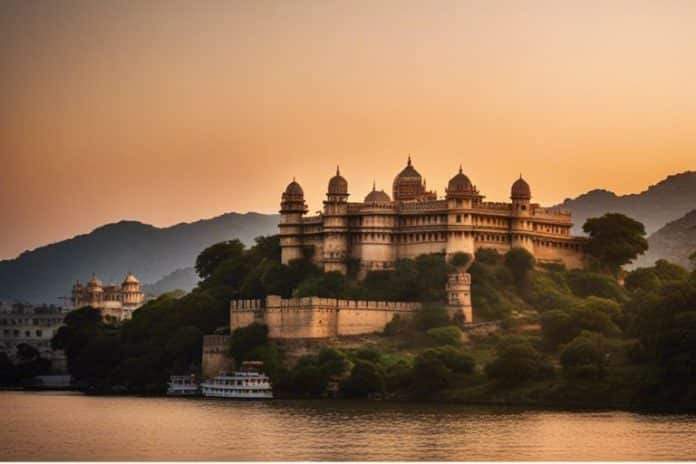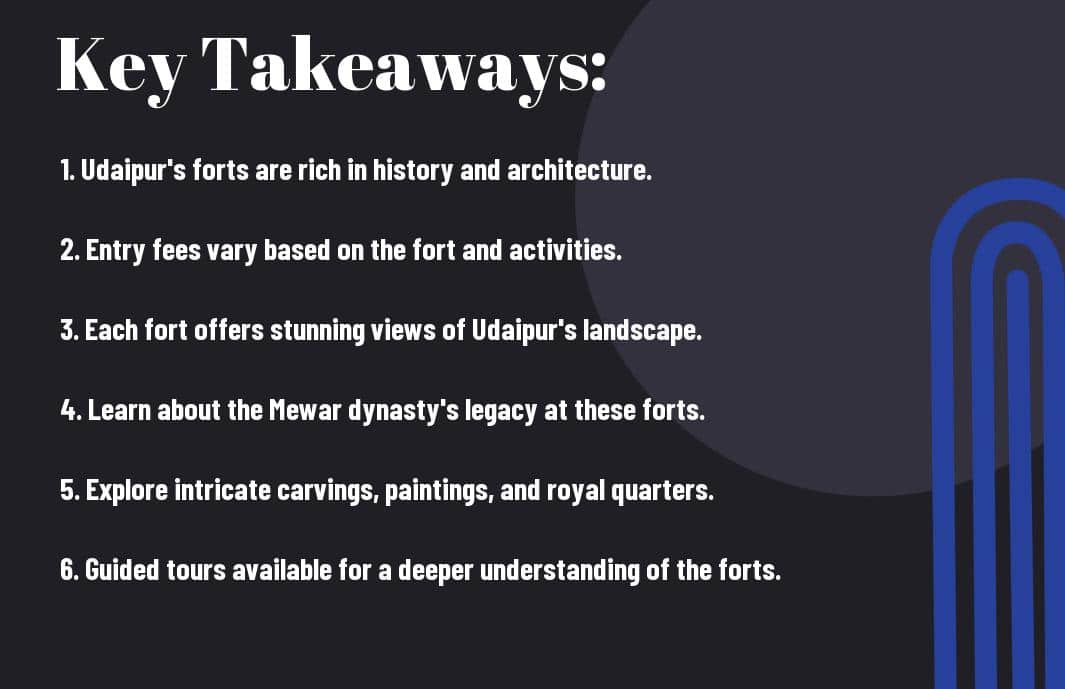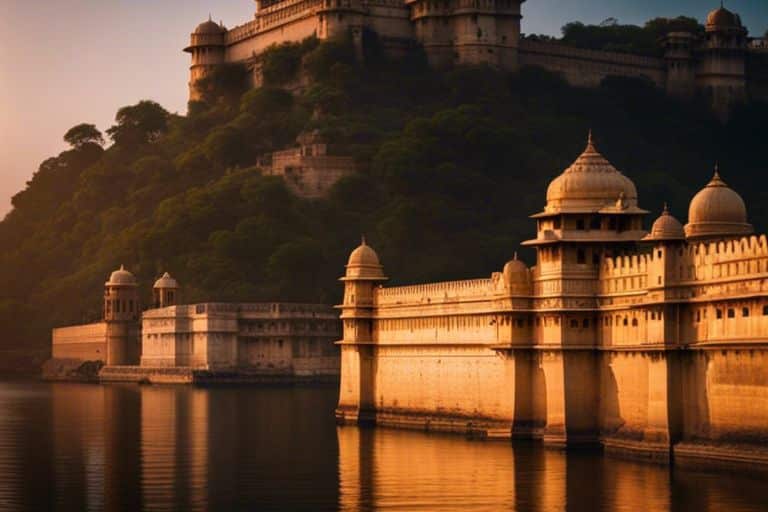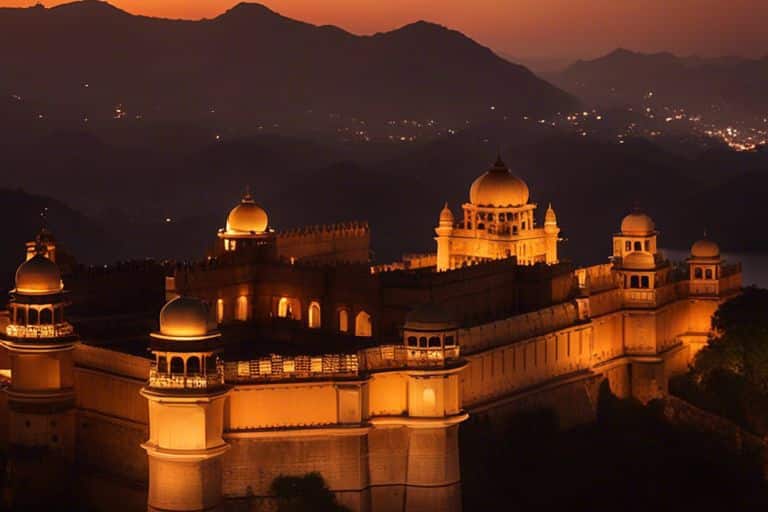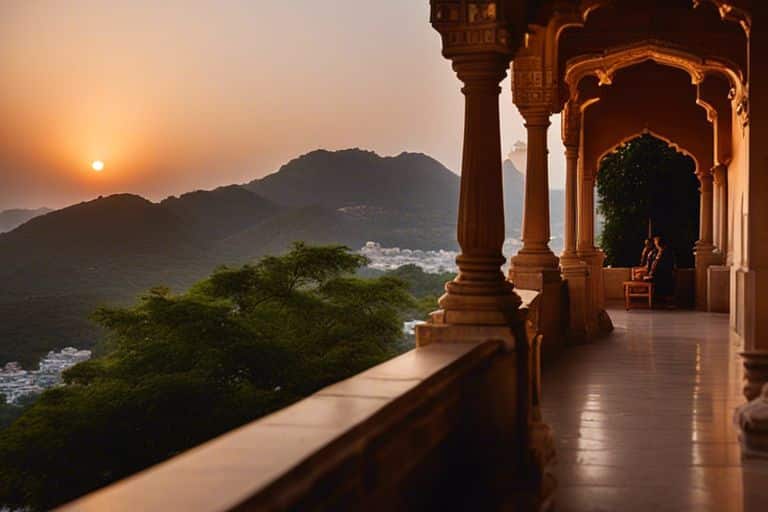Overlooking the picturesque city of Udaipur stand some of the most magnificent forts in India, each with its own historical significance and architectural marvel. These forts not only offer a glimpse into the royal past of Rajasthan but also provide visitors with a breathtaking view of the surrounding landscapes.
One of the most iconic forts in Udaipur is the City Palace, which showcases a blend of Rajasthani and Mughal architecture. The entry fee for this grand structure is nominal, allowing tourists to explore the opulent rooms, museums, and courtyards that are steeped in history and culture. Another must-visit fort is the majestic Kumbhalgarh Fort, known for its expansive walls that stretch over 36 kilometers and offer a panoramic view of the Aravalli Range.
For history enthusiasts and adventure seekers alike, exploring the forts in Udaipur is a truly enriching experience. From the formidable walls of Chittorgarh Fort to the intricate carvings of Sajjangarh Fort, each fortress has a story to tell and a unique charm to behold. So, come and immerse yourself in the royal heritage of Udaipur by visiting these architectural marvels that have stood the test of time.
Key Takeaways:
- Rich Historical Significance: The forts in Udaipur hold great historical significance dating back to the Rajput era, showcasing the valiant tales of battles and royalty.
- Architectural Marvels: These forts are architectural marvels featuring intricate carvings, impressive structures, and stunning designs that reflect the grandeur of the past.
- Spectacular Views: Visitors can enjoy breathtaking panoramic views of Udaipur city, Lake Pichola, and the Aravalli Mountains from these majestic forts.
- Entry Fees: Each fort in Udaipur has a nominal entry fee for visitors, offering a glimpse into the opulent lifestyle and strategic defenses of the bygone era.
- Must-Visit Attractions: The must-visit forts in Udaipur include the City Palace, Sajjangarh Palace (Monsoon Palace), and Kumbhalgarh Fort, each offering a unique insight into the region’s history.
- Cultural Heritage: Exploring these forts provides a deep investigate the rich cultural heritage of Udaipur, showcasing the art, architecture, and traditions of the region.
- Photography Opportunities: These forts offer excellent photography opportunities, allowing visitors to capture the beauty and grandeur of the fortresses against the backdrop of picturesque landscapes.
Understanding the Architecture of Udaipur’s Forts
If you are fascinated by the grand forts of Udaipur, then delving into the architectural styles and influences behind these magnificent structures is a must.
Architectural Styles and Influences
Udaipur’s forts showcase a blend of Rajput and Mughal architectural styles, reflecting the rich cultural history of the region. The intricate carvings, domes, courtyards, and balconies adorned with colorful glass and mirrors are a testament to the artistic prowess of the craftsmen of that era.
Forts in Udaipur also bear influences from various other architectural styles due to the city’s strategic location along ancient trade routes. The forts’ strategic positions atop hills not only served defensive purposes but also provided breathtaking panoramic views of the surrounding landscapes. This amalgamation of styles and influences has resulted in forts that are not only structurally sound but also visually striking.
Exploring the forts’ interiors reveals intricate frescoes, ornate ceilings, and finely detailed stonework that have withstood the test of time. The architectural nuances of these forts offer a glimpse into the opulence and grandeur of the bygone eras, leaving visitors in awe of the skilled craftsmanship and design sensibilities of the past.
Construction Techniques Through The Ages
Forts in Udaipur have been witness to various construction techniques evolving through the ages.
The early forts were built using traditional materials like stones, mud, and wood, with an emphasis on sturdy fortifications to withstand enemy attacks. As architectural techniques advanced, the forts saw the addition of intricately designed gates, underground tunnels, and reservoirs for water storage to ensure sustenance during sieges.
The construction techniques employed through the ages highlight the engineering marvels of their time, showcasing the ingenuity and foresight of the builders. Each fort in Udaipur narrates a story of evolving construction methods, adapting to the changing needs of defense and comfort without compromising on the artistic beauty that defines them.
With the architectural styles and construction techniques blending seamlessly, Udaipur’s forts stand as a testament to the rich history and cultural heritage of the region. Visiting these forts not only offers a glimpse into the past but also a deep appreciation for the architectural marvels that have withstood the ravages of time.
Kumbhalgarh Fort – A Majestic Legacy
Once again, we explore into the rich history of one of the most magnificent forts in Udaipur – Kumbhalgarh Fort. This awe-inspiring fortress stands tall with its majestic walls and intricate architecture, showcasing a legacy that has stood the test of time.
Historical Background of Kumbhalgarh Fort
Kumbhalgarh Fort, located in the Rajsamand district of Rajasthan, was built in the 15th century by Rana Kumbha. It is renowned for its massive walls that stretch over 36 kilometers, making it the second-longest continuous wall after the Great Wall of China. The fort served as a refuge for the rulers of Mewar during times of war, thanks to its strategic location amidst the Aravalli hills.
The fort has a tumultuous history, having been attacked multiple times but never conquered. It stood as a symbol of the Rajputana resistance against the Mughal forces. The most notable historical event associated with Kumbhalgarh Fort is the sacrifice of Prince Udai, infant son of Rana Udai Singh, who was smuggled out of the fort to establish the future lineage of Mewar.
Today, Kumbhalgarh Fort stands as a UNESCO World Heritage Site, attracting history buffs and architecture enthusiasts from around the globe. Its soaring towers, intricate palaces, and picturesque surroundings make it a must-visit destination for anyone exploring the forts of Rajasthan.
Visitor’s Guide: Entry Fees and Timings
With a nominal entry fee of INR 15 for Indian nationals and INR 200 for foreign tourists, visiting Kumbhalgarh Fort is an affordable experience for all. The fort is open to visitors from 9:00 AM to 6:00 PM, allowing ample time to explore its various sections and soak in the historical ambiance.
For those interested in a guided tour, services are available at an additional cost to provide in-depth insights into the fort’s history and architecture. It is advisable to allocate at least 2-3 hours for a comprehensive exploration of the vast fort complex.
Background: Visitors can enjoy a light and sound show held in the evenings, bringing to life the tales of valor and sacrifice associated with Kumbhalgarh Fort. The show adds an immersive layer to the historical significance of the fortress, making it a memorable experience for visitors of all ages.
Exploring the Great Wall of Kumbhalgarh
Fees deemed very reasonable at INR 200 for a guided tour up to the fort wall and INR 400 for the same along with a guide to the Badal Mahal and the pinnacle viewpoint, further cementing Kumbhalgarh Fort as a must-visit destination in Udaipur.
Historical: The Great Wall of Kumbhalgarh is a standout feature of the fort, offering panoramic views of the surrounding countryside. It served as a formidable defense structure, protecting the kingdom of Mewar from invasions and ensuring its survival through turbulent times.
Sajjangarh Fort – The Monsoon Palace
Keep Most Famous Rajasthan Forts & Palaces You Should Visit in mind when planning your visit to Udaipur, as the city boasts some of the most magnificent forts in Rajasthan. One such fort that stands out is the Sajjangarh Fort, also known as the Monsoon Palace. Perched on a hilltop overlooking the picturesque city of Udaipur, this fort offers breathtaking panoramic views of the surrounding landscapes.
The Story Behind Sajjangarh Fort
Monsoon Palace, as the Sajjangarh Fort is commonly referred to, was built in the late 19th century by Maharana Sajjan Singh of the Mewar Dynasty. The primary purpose of constructing this fort was to serve as a summer retreat for the royal family. The location was chosen strategically to enjoy the cool breeze and panoramic views of the city during the monsoon season. Today, it stands as a symbol of architectural brilliance and historical significance in Udaipur.
Key Attractions and Viewing Points
An crucial feature of the Sajjangarh Fort is its stunning architecture, which seamlessly blends Rajasthani and Mughal styles. The fort’s terrace offers unparalleled views of Fateh Sagar Lake and the surrounding Aravalli Hills, making it a perfect spot for photographers and nature enthusiasts. Visitors can also explore the Fateh Prakash Palace, an exquisite structure within the fort complex that showcases the opulence of the Mewar Dynasty.
The ornate balconies and intricately designed pillars of the fort are a sight to behold, reflecting the artistic genius of the craftsmen of that era. The fort’s reflecting pools and lush green gardens add to its charm, creating a serene ambiance for visitors to relax and unwind. Exploring the fort’s various chambers and corridors gives a glimpse into the royal lifestyle and architectural finesse of the bygone era.
Ticket Information for Tourists
The Sajjangarh Fort welcomes tourists with different ticket options based on their preferences. Foreign tourists can avail themselves of a separate ticket that includes entry to the fort and access to specific areas within the complex. Additionally, there are guided tours available for those interested in delving deeper into the history and significance of the fort. The ticket prices are reasonable, considering the experience and insights one gains during the visit.
Sajjangarh Fort is open to visitors from morning till evening, allowing ample time to explore its various attractions and soak in the majestic views it offers. The fort’s ticket counter provides information on timings, ticket prices, and any special events or exhibitions taking place during your visit. Make sure to plan your visit in advance to make the most of your time at this historical marvel in Udaipur.
Chittorgarh Fort – A Symbol of Rajput Pride
The Saga of Chittorgarh Fort
Now, let’s probe into the captivating saga of Chittorgarh Fort, a symbol of Rajput valor and resilience. This imposing fort stands as a testament to the rich history of Rajasthan, echoing stories of battles fought and sacrifices made in the name of honor and pride.
One of the largest forts in India, Chittorgarh Fort has witnessed several sieges and battles over the centuries. Its sheer size and strategic location atop a hill have made it an impregnable stronghold, attracting invaders and admirers alike.
The fort’s architecture is a blend of Rajput and Mughal styles, reflecting the cultural influences of its varied rulers. From ornate palaces to imposing gates, every corner of Chittorgarh Fort exudes a sense of grandeur and majesty.
Points of Interest Within the Fort Precincts
Fort: Within the sprawling complex of Chittorgarh Fort, visitors can explore a wealth of historic sites and architectural marvels. The iconic Victory Tower, Kirti Stambh, and Rana Kumbha Palace are just a few of the noteworthy attractions that await exploration.
It is advisable to hire a guide to fully appreciate the significance of each structure and the stories they hold. The intricate carvings, intricate designs, and panoramic views from the fort walls make it a photographer’s paradise and a history enthusiast’s delight.
Exploring the fort precincts on foot can be a daunting task due to its vastness, so wearing comfortable shoes and carrying water is highly recommended to fully enjoy the experience.
Understanding Entry Fees and Visitation Protocols
Chittorgarh: To experience the grandeur of Chittorgarh Fort, visitors must pay a nominal entry fee, which helps in the conservation and maintenance of this historical treasure. The entry fees vary for Indian and foreign tourists, with additional charges for photography and videography.
It is important to adhere to the visitor guidelines and regulations laid out by the authorities to ensure a safe and enriching visit. Respecting the cultural heritage of the fort by not littering or defacing its structures is of paramount importance.
To make the most of your visit to Chittorgarh Fort, plan ahead and allocate sufficient time to explore its myriad attractions at a leisurely pace, soaking in the history and grandeur of this magnificent fortress.
The Twin Forts: Fateh Prakash Palace and Shiv Niwas Palace
Dual History and Combined Heritage
All great cities have their twin jewels, and in Udaipur, it is the majestic Fateh Prakash Palace and Shiv Niwas Palace. These twin forts stand as a testament to the glorious history of the Mewar dynasty, showcasing a blend of Rajput and Mughal architectural styles that mesmerize visitors from all corners of the world.
While Fateh Prakash Palace exudes grandeur and opulence with its intricate carvings and stunning courtyards, Shiv Niwas Palace offers a more intimate glimpse into the royal lifestyle with its beautiful balconies and serene surroundings. Together, these palaces present a harmonious symphony of history and heritage that is truly awe-inspiring.
Visitors can explore the interconnected passages and unique design elements that link Fateh Prakash Palace and Shiv Niwas Palace, understanding the shared stories and legacies of the past rulers who once resided within these magnificent walls.
Exploring the Palatial Complexes
Palace enthusiasts are in for a treat as they wander through the sprawling complex of Fateh Prakash Palace and Shiv Niwas Palace. Each corner tells a story of bygone eras, with ornate furnishings, lavish decor, and stunning views of Lake Pichola that transport visitors to a time of regal splendor.
One cannot help but marvel at the exquisite craftsmanship displayed in every nook and cranny, from the intricate ceiling designs to the beautifully landscaped gardens that evoke a sense of tranquility amidst the bustling city. The palatial complexes offer a true feast for the senses, inviting guests to immerse themselves in the majestic charm of Udaipur’s royal heritage.
For those seeking a glimpse into the royal lifestyle, Fateh Prakash Palace and Shiv Niwas Palace provide an unparalleled experience that is both fascinating and enriching. The architectural marvels and historical significance make these twin forts a must-visit destination for history buffs and culture aficionados alike.
Entry Details and Heritage Walks
With guided heritage walks and informative tours, visitors can explore deeper into the wealth of history that surrounds Fateh Prakash Palace and Shiv Niwas Palace. Knowledgeable guides shed light on the intricate details and hidden stories behind each architectural marvel, offering a more immersive experience for those eager to learn about the royal legacy of Udaipur.
Plus, visitors have the opportunity to explore restricted areas and exclusive chambers that are off-limits to the public, gaining a rare insight into the private world of the erstwhile rulers. These heritage walks provide a unique chance to connect with the past and appreciate the cultural significance of these magnificent forts.
Exploring the Lesser-Known Forts of Udaipur
For an in-depth exploration of Udaipur’s fort heritage, one must not miss out on the hidden gems that lie beyond the popular tourist spots. While Udaipur boasts of grand forts like the City Palace and Sajjangarh Palace, there are several lesser-known forts that hold historical significance and architectural beauty. To discover these hidden treasures, check out our blog on 5 Must-Visit forts in Udaipur.
Bala Quila – The Young Fort
For a glimpse into the history of Udaipur, Bala Quila is a must-visit. Situated on a hill overlooking the city, this fort offers breathtaking views of the surrounding landscapes. Built in the 18th century, Bala Quila stands as a symbol of strength and resilience. The fort’s architecture reflects a blend of Rajput and Mughal styles, showcasing intricate carvings and ornate designs.
Exploring the premises of Bala Quila, visitors can witness ancient cannons, massive gates, and intricate wall paintings that narrate tales of battles and triumphs. The fort also houses a museum that displays artifacts and relics from the bygone era, providing a deeper insight into Udaipur’s rich history.
Stepping into Bala Quila is like stepping back in time, where every stone tells a story. The serenity and grandeur of this young fort make it a perfect destination for history enthusiasts and architecture aficionados who wish to unravel the mysteries of Udaipur’s past.
Jagmandir Island Palace – The Lake Garden Palace
Island retreats have always held a special charm, and Jagmandir Island Palace is no exception. Nestled in the midst of Lake Pichola, this architectural marvel offers a serene escape from the hustle and bustle of the city. The palace, also known as the Lake Garden Palace, is renowned for its marble structures, pristine gardens, and tranquil surroundings.
The history of Jagmandir Island Palace dates back to the 17th century when it served as a royal retreat for the Mewar dynasty. Legend has it that Emperor Shah Jahan drew inspiration for the Taj Mahal from the intricate designs of this exquisite palace. Visitors can wander through the lush gardens, admire the intricate architecture, and immerse themselves in the royal opulence of Jagmandir Island Palace.
A visit to this hidden gem is a journey through time, where the whispers of the past echo in every corner. The serene beauty of Lake Pichola surrounding the palace adds to its allure, making it a must-visit destination for tranquility seekers and history buffs alike.
Structure and Entrance Details of the Obscure Forts
Younger forts like Bala Quila and serene retreats like Jagmandir Island Palace may often be overlooked in the grandeur of Udaipur’s more popular attractions. However, these obscure forts hold a charm of their own, offering visitors a unique glimpse into the city’s rich heritage. The structures of these forts boast intricate carvings, ornate domes, and majestic ramparts that speak volumes about Udaipur’s architectural prowess.
The entrance to these obscure forts is like stepping into a time portal, where each doorway leads to a realm of history and splendor. Visitors can witness ancient gateways, weathered walls, and time-worn corridors that transport them to a bygone era. The architectural details and design elements of these forts are a true testament to the skilled craftsmanship and artistic flair of the artisans of yesteryears.
Exploring the structure and entrance details of these lesser-known forts is a rewarding experience, offering a glimpse into Udaipur’s hidden treasures. The serenity and grandeur of these forts create an aura of mystique, inviting visitors to explore into the mysteries of the past and unravel the secrets of Udaipur’s fort legacy.
The Historical Significance of Forts in Rajasthan
Role in Defense and Warfare
To truly appreciate the historical significance of forts in Rajasthan, one must understand their crucial role in defense and warfare. These majestic structures were not merely architectural marvels but also formidable strongholds that played a key role in protecting the region from invasions. The strategic location of forts atop hills or in difficult terrain made them almost impregnable, allowing the rulers to defend their kingdoms against enemy attacks. The thick walls, bastions, and intricate maze-like pathways inside the forts were designed to confuse and trap invaders, making it extremely challenging for them to conquer the fortresses.
The forts in Rajasthan were not just military outposts but also served as administrative centers where rulers governed their territories. The layout of these forts often included palaces, temples, and other structures that showcased the wealth and power of the ruling dynasties. In times of peace, these forts became symbols of authority and strength, instilling a sense of awe and fear in the hearts of the subjects. The architectural splendor of these forts reflected the artistic and engineering prowess of the craftsmen and engineers who built them, making them not just military fortresses but also cultural landmarks.
Over the centuries, several major battles were fought around these forts, shaping the history and destiny of Rajasthan. The stories of bravery and valor associated with these forts became legendary, inspiring future generations to uphold the honor and glory of their ancestors. The forts in Rajasthan stand as silent witnesses to the turbulent past of the region, reminding us of the sacrifices made by countless warriors to protect their homeland.
Centers of Culture and Power
Culture and power were intricately intertwined in the forts of Rajasthan, making them centers of influence and wealth. The elaborate courtyards, intricately carved pillars, and majestic palaces inside these forts spoke volumes about the cultural richness of the region. The rulers patronized artists, musicians, and poets, transforming the forts into hubs of artistic and intellectual activities. Festivals, fairs, and royal gatherings held within the walls of these forts showcased the opulence and grandeur of Rajputana royalty, attracting visitors from far and wide.
Rajasthan was not just a land of warriors but also a cradle of art and architecture. The forts in Rajasthan served as the nucleus of cultural exchange, where ideas and traditions were shared and preserved for future generations. The intricate frescoes, murals, and sculptures adorning the walls of these forts depicted scenes from epics, historical events, and daily life, providing a glimpse into the rich heritage of Rajasthan. The forts were not just mute relics of the past but living symbols of a bygone era, resonating with the echoes of glory and grandeur.
Preserving Udaipur’s Forts for Future Generations
Conservation Efforts and Challenges
With Udaipur’s forts being significant historical landmarks, there has been a concerted effort to preserve them for future generations. The conservation efforts include regular maintenance, restoration projects, and implementing sustainable practices to ensure the longevity of these architectural marvels. However, these efforts are not without challenges.
One of the primary challenges faced in the conservation of Udaipur’s forts is the lack of proper funding. Maintenance and restoration projects require significant financial resources, and sometimes the government funding allocated may not be sufficient. As a result, it becomes crucial to seek alternative sources of funding through public-private partnerships or seeking donations from individuals and organizations passionate about preserving heritage sites.
Additionally, balancing the need for tourism with conservation efforts is another challenge. While tourism can provide the necessary funds for preservation, it also brings with it the risk of over-commercialization and excessive footfall that can damage the delicate structures. Striking a balance between promoting tourism and safeguarding the forts’ integrity is a delicate task that requires careful planning and management.
How Tourism Impacts Fort Preservation
Any discussion on preserving Udaipur’s forts for future generations would be incomplete without addressing the impact of tourism on these historical sites. Tourism plays a significant role in raising awareness about the forts and generating revenue for their conservation. However, it also poses some challenges.
The influx of tourists can lead to wear and tear on the forts’ structures and contribute to environmental degradation. Managing tourist flow, enforcing visitor guidelines, and educating tourists on the importance of respecting the heritage sites are vital steps in mitigating these impacts. By promoting responsible tourism practices and fostering a sense of stewardship among visitors, we can ensure that Udaipur’s forts remain preserved for generations to come.
More Info on How Tourism Impacts Fort Preservation
Conservation efforts also involve creating awareness programs, implementing sustainable tourism practices, and enlisting the support of local communities in preserving the forts. By involving all stakeholders in the conservation process, we can ensure that Udaipur’s forts continue to stand as proud symbols of the city’s rich history and cultural heritage.
Planning Your Visit to Udaipur’s Historic Forts
Unlike other tourist destinations, exploring the historic forts in Udaipur requires some meticulous planning to make the most of your visit. Before initiateing on your adventure, it’s important to familiarize yourself with the entrance fees, timings, and other crucial details. For a comprehensive guide on Udaipur’s monuments’ entrance fees and timings, check out Udaipur Monuments Entrance Fees and Timings 2024.
Best Time to Visit
Visit Udaipur’s historic forts during the winter months from October to March when the weather is pleasant and ideal for sightseeing. The cool breeze and clear skies provide a perfect backdrop for exploring the grandeur of these magnificent structures. Avoid visiting during the scorching summer months to ensure a comfortable and enjoyable experience.
During the monsoon season from July to September, the forts may appear even more enchanting as the surrounding landscape turns lush green. However, be cautious of slippery paths and limited accessibility during heavy rainfall. Plan your visit accordingly to make the most of your time exploring these historical treasures.
For photography enthusiasts, the early morning or late afternoon light during the winter months offers stunning views of the forts against the backdrop of the rising or setting sun. Capture the beauty and grandeur of these ancient fortresses in the soft, golden light for a truly unforgettable experience.
Comprehensive Guide to Fees and Tours
Any visit to Udaipur’s historic forts requires careful consideration of entrance fees, guided tours, and additional charges for specific attractions within the premises. Most forts offer guided tours led by knowledgeable experts who provide in-depth insights into the historical significance and architectural marvels of these structures.
This detailed guide will help you navigate through the various fees and tour options available at Udaipur’s forts, ensuring a hassle-free and enriching experience during your visit. Familiarize yourself with the fee structure and tour details beforehand to plan your itinerary efficiently and make the most of your time exploring these iconic landmarks.
Cultural Etiquette and Tips for Visitors
Planning your visit to Udaipur’s historic forts also involves understanding and respecting the cultural etiquette observed at these heritage sites. Respect local customs and traditions by dressing modestly and removing your shoes before entering sacred areas within the forts.
- Be mindful of photography restrictions in certain areas.
- Respect the silence in religious spaces.
- Interact respectfully with locals and fellow visitors.
This cultural sensitivity will not only enhance your experience but also show your appreciation for the rich heritage and traditions preserved within Udaipur’s historic forts.
Reflecting on Udaipur’s Forts as Living Monuments
Etiquette plays a crucial role in preserving the sanctity and historical significance of Udaipur’s forts. As you explore these magnificent structures, remember to treat them with the utmost respect and admiration they deserve. Learn about the architectural styles, legends, and cultural heritage embedded within the walls of these living monuments.
To fully immerse yourself in the history and grandeur of Udaipur’s forts, consider hiring a knowledgeable guide who can provide fascinating insights and stories about the rulers, battles, and architectural marvels that shaped these iconic landmarks.
How These Forts Continue to Shape Udaipur’s Identity
Tours of Udaipur’s forts offer a unique opportunity to investigate into the city’s rich past and understand how these monumental structures continue to influence its cultural identity. Immerse yourself in the grandeur and history of forts like the City Palace, Sajjangarh Palace, and Kumbhalgarh Fort to gain a deeper appreciation for Udaipur’s heritage.
Exploring these forts will not only provide a glimpse into the royal legacy of Udaipur but also showcase the architectural brilliance and strategic prowess of the rulers who once inhabited these majestic fortresses. Witness firsthand how these forts stand as testaments to Udaipur’s enduring legacy and cultural significance.
FAQ
Q: What are some of the magnificent forts to explore in Udaipur?
A: Some of the magnificent forts to explore in Udaipur are the City Palace, Sajjangarh Palace, and Kumbhalgarh Fort.
Q: What is the entry fee for visiting the City Palace in Udaipur?
A: The entry fee for visiting the City Palace in Udaipur is INR 300 for Indians and INR 600 for foreigners.
Q: What is the historical significance of the Sajjangarh Palace in Udaipur?
A: The Sajjangarh Palace, also known as the Monsoon Palace, was built by Maharana Sajjan Singh of Udaipur in the late 19th century. It served as a retreat for the royal family during the monsoon season and offers panoramic views of the city.
Q: How much does it cost to visit the Kumbhalgarh Fort near Udaipur?
A: The entry fee for visiting the Kumbhalgarh Fort near Udaipur is INR 15 for Indians and INR 200 for foreigners.
Q: What makes the City Palace in Udaipur a must-visit attraction?
A: The City Palace is a blend of Rajasthani and Mughal architectural styles and houses a museum with a remarkable collection of artifacts, weapons, and paintings. It offers a glimpse into the opulent lifestyle of the royal family.
Q: Are there guided tours available for exploring the forts in Udaipur?
A: Yes, there are guided tours available for exploring the forts in Udaipur. These tours provide insightful information about the history, architecture, and significance of the forts.
Q: What is the best time to visit the forts in Udaipur?
A: The best time to visit the forts in Udaipur is during the winter months from October to March when the weather is pleasant and ideal for exploring the historical sites.
